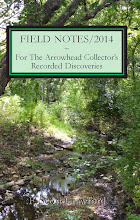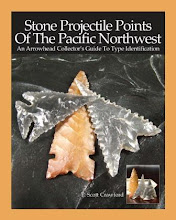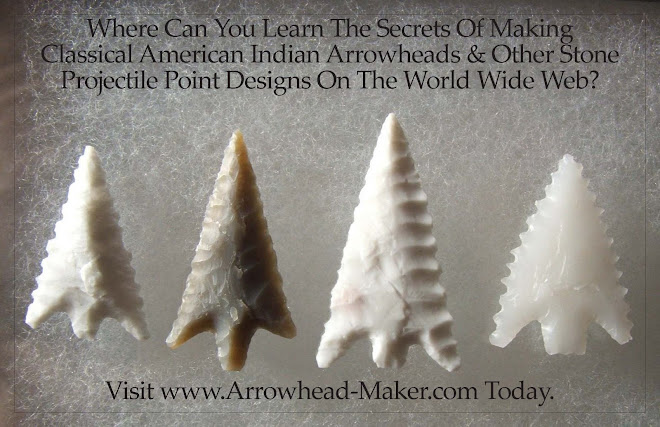Anyway, when he came by the house, I was working on an obsidian blade. It's made from a spall of transparent black obsidian from eastern Oregon . Originally I used the chunk of obsidian to produce a good number of the middle sized chips which are used in the Beginner's Kit for making arrowheads.
After these chips were removed, I had left what is referred to as a "core". I worked on the core a little more with my percussion tools to end up with a fairly large "pre-form" for a spear point or knife.
Then I began using pressure flaking to remove the rough parts and prepare for finishing the blade. Eventually, I had the piece worked down to the condition where I was ready to finish its form with some careful pressure flaking.
I was about half finished with the final series of pressure flakes when Mike showed up.
So, I took the opportunity to show him how the edge of the blade was set up for that finishing series. Making the edge angles correctly, grinding the edge enough to give the pressure flaking tool a good seat and grip, so that it will not slip off. Plus, retaining enough material mass at the ground edge to have sufficient strength to resist the pressure load until the force is built up enough to drive the desired flake a long way across the face of the blade.
Fortunately, I had good luck with the impromptu demonstration for Mike. The finishing of this blade went well.
 So, here it is. It is what is called an Agate Basin blade. This was a Paleo-Indian weapon used for hunting large game at the end of the Ice Age; woolly mammoths, giant buffalo, etc. These were used at the same time and after the Clovis type weapons which are so famous for their uniquely thinned, fluted bases. The Agate Basin point is just not fluted, so it has the lens shaped cross section for the full length of the blade.
So, here it is. It is what is called an Agate Basin blade. This was a Paleo-Indian weapon used for hunting large game at the end of the Ice Age; woolly mammoths, giant buffalo, etc. These were used at the same time and after the Clovis type weapons which are so famous for their uniquely thinned, fluted bases. The Agate Basin point is just not fluted, so it has the lens shaped cross section for the full length of the blade.F. Scott Crawford
Carrollton, Texas
You are invited to visit my web site for more background information and photographs related to the making of arrowheads: http://www.arrowhead-makeyourown.com/
For fully photo-illustrated process information related to the making of an obsidian Gunther style arrowhead, plus photographs of a number of ancient and authentic Gunther type arrowheads, you are invited to visit my other web site: http://www.arrowhead-maker.com/






![[Most Recent Quotes from www.kitco.com]](http://www.kitconet.com/charts/metals/gold/t24_au_en_usoz_2.gif)

